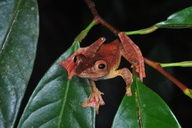|
Rhacophorus pardalis Günther, 1858
Harlequin Tree Frog, Gliding Tree Frog, Panther Tree Frog | family: Rhacophoridae subfamily: Rhacophorinae genus: Rhacophorus |
 © 2017 Dr. Peter Janzen (1 of 15)
|
|
|
|
Description Dorsum is tan to reddish brown, often with an X-shaped darker marking on the back. Several white spots are often present, with some individuals having yellow or blue spots on the dorsal surfaces. Flanks are yellowish with black spots. Venter is yellowish with orange reticulation. Webbing is orange-red (Inger and Stuebing 2005). The tadpole has an oval, deep body, with total length reaching up to 45 mm. The tail has a narrow tip. Body is pale light brown. Black spots may be present on the body, or just a single spot on the side of the head. Spotting pattern can resemble that of Rana chalconota, but R. pardalis tadpoles lack white glandular patches on the venter (Inger and Stuebing 2005). Distribution and Habitat Country distribution from AmphibiaWeb's database: Indonesia, Malaysia, Philippines Malaysian region distribution from AmphibiaWeb's database: Peninsular Malaysia, Sabah, Sarawak
Life History, Abundance, Activity, and Special Behaviors Trends and Threats Possible reasons for amphibian decline Habitat modification from deforestation, or logging related activities
References
Diesmos, A., Alcala, A., Brown, R., Afuang, L., Gee, G., Sukumaran, J., Yaakob, N., Tzi Ming, L., Chuaynkern, Y., Thirakhupt, K., Das, I., Iskandar, D., Mumpuni, Inger, R., Stuebing, R., Yambun, P., and Makl 2004. Rhacophorus pardalis. In: IUCN 2008. 2008 IUCN Red List of Threatened Species. www.iucnredlist.org. Downloaded on 27 April 2009. Harvey, M. B., Pemberton, A. J., and Smith, E. N. (2002). ''New and poorly known parachuting frogs (Rhacophoridae: Rhacophorus) from Sumatra and Java.'' Herpetological Monographs, 16, 46-92. Inger, R. F. and Stuebing, R. B. (2005). A Field Guide to the Frogs of Borneo, 2nd edition. Natural History Publications (Borneo), Kota Kinabalu. Originally submitted by: Kellie Whittaker (first posted 2009-04-20) Edited by: Kellie Whittaker (2014-10-29) Species Account Citation: AmphibiaWeb 2014 Rhacophorus pardalis: Harlequin Tree Frog <https://amphibiaweb.org/species/4529> University of California, Berkeley, CA, USA. Accessed Jun 1, 2025.
Feedback or comments about this page.
Citation: AmphibiaWeb. 2025. <https://amphibiaweb.org> University of California, Berkeley, CA, USA. Accessed 1 Jun 2025. AmphibiaWeb's policy on data use. |





 Map of Life
Map of Life